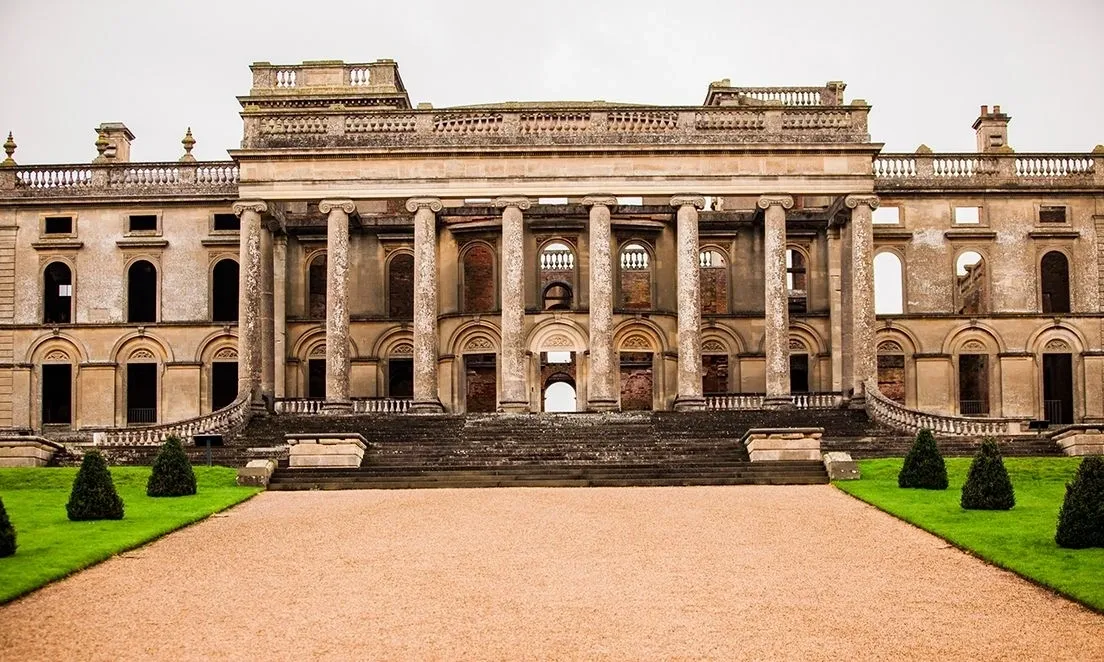Witley Court, a magnificent country estate in England, was once a symbol of grandeur and opulence. However, tragedy struck in 1937 when a devastating fire left it as a breathtaking ruin, securing its position among the nation’s most remarkable remnants.
The history of Witley Court dates back to the 13th century, with significant developments occurring over the centuries. By the late 15th century, a substantial new house adorned the grounds, followed by extensive renovations and expansions in the early 17th century.

Three decades later, the estate changed hands and was acquired by the Foley family, renowned for their industrial achievements. Under their ownership, significant enhancements were made to Witley Court. They expanded the house, renovated the nearby church, and created a picturesque lake on the property.
During the Foley family’s tenure, the esteemed architect John Nash was enlisted to update the estate, particularly focusing on modernizing the house’s interiors in the popular neoclassical fashion.
Subsequently, the estate passed into the hands of William Ward, 1st Earl of Dudley, a prominent industrialist of substantial wealth. Under his patronage, the house underwent a significant transformation in the 1850s, adopting the fashionable Italianate style reminiscent of Queen Victoria’s renowned seaside retreat, Osborne House.

Under the stewardship of William Ward, 1st Earl of Dudley, Witley Court underwent further enhancement with the involvement of renowned designer W. A. Nesfield, who crafted extravagant gardens featuring magnificent fountains that complemented the revamped house.
Critics of the time were both awed and perplexed by the garden’s opulence, with one describing it as “barbarous in its magnificence.” During the late 19th and early 20th centuries, Witley Court embodied luxury and extravagance, hosting legendary house parties that were the talk of high society.
Successively owned by some of England’s wealthiest families, the estate was acquired from the Foleys in 1837 for a staggering sum equivalent to around £48 million today. The 1st and 2nd Earls of Dudley possessed vast estates spanning England and Wales, many of which included lucrative coal mines, significantly contributing to their wealth.
With its illustrious ownership and lucrative assets, Witley Court naturally became a hub of opulence, hosting elaborate shooting parties and receiving visits from royalty. This grand edifice, once a sprawling conservatory, stood as a testament to the opulence and grandeur of its era.


Lord Dudley’s substantial annual income, amounting to approximately £7 million in today’s currency, provided the financial means to undertake enhancements at Witley Court, including the creation of intricate formal gardens.
These opulent gardens served as a fitting backdrop for the extravagant pursuits that unfolded. In 1895, a meticulously laid-out golf course was added, further enhancing the estate’s allure.
The grandeur of Witley Court extended beyond its physical attributes, as evidenced by the elaborate parties it hosted. Behind the scenes, a veritable army of over one hundred permanent staff, including housemaids, a butler, and gardeners, ensured that every detail was meticulously attended to.

The era of opulence at Witley Court came to a tragic end in 1937, marking the final chapter for this once-magnificent estate as it fell victim to flames. The 2nd Earl of Dudley’s extravagant spending depleted his fortune, leading to the sale of the estate to industrialist Sir Herbert Smith in 1920.
Despite Sir Herbert’s wealth, he adopted a more modest approach compared to his predecessor, significantly reducing the number of staff to just a handful of maids and a butler. He confined himself to a small portion of the house, essentially abandoning the rest of Witley Court.
On the fateful evening of September 7, 1937, disaster struck as a fire broke out in a basement bakery, rapidly fueled by strong winds. Sir Herbert was absent, leaving his remaining staff to battle the blaze in vain. Although many of the estate’s contents were salvaged, the inadequate hydrant system and supposedly “fireproof” floors proved ineffective, resulting in the extensive destruction of the central and eastern sections of the house.

The aftermath of the fire revealed a harsh reality: insurance funds would only cover a fraction of the expenses needed to rebuild Witley Court. Faced with this financial burden, Sir Herbert Smith made the difficult decision to sell off the property, including its gardens.
In 1938, the surviving contents of the house, along with numerous garden ornaments, were auctioned off in an attempt to recoup some of the losses. However, the state of ruin at Witley Court was not solely the result of the devastating fire.
In 1954, the estate was purchased by an antique dealer from Stratford-upon-Avon. Seeking to capitalize on any remaining value, the new owner systematically stripped the property of its valuable assets. Marble chimneypieces, lead, timber from the roof, and even the glass from the conservatory were removed and sold off, further contributing to Witley Court’s decline.

Throughout the 1950s and 1960s, Witley Court narrowly escaped the threat of demolition, with some even proposing the establishment of a motor-racing circuit on its grounds. Fortune smiled upon Witley in 1964 when a Building Preservation Order was issued, providing crucial protection to the estate. This safeguarding was further reinforced in 1970 when both the house and its surroundings were officially designated as an Ancient Monument.
Since 1984, Witley Court has been under the care of English Heritage, ensuring its preservation for future generations. A notable example of English Heritage’s commitment to preserving Witley Court’s heritage is evident in the restoration of the Perseus and Andromeda fountain. This exquisite fountain, crafted in the 1850s from intricately carved Portland stone, depicts the mythological scene of Perseus coming to the aid of Andromeda, who is chained to a rock by the sea god Poseidon. Surrounding the central scene are cupids riding dolphins, while the main jet of water in the fountain reportedly reaches an impressive height of 36 meters.
Before the estate received the protection it deserved, this magnificent fountain faced the risk of being relocated to a traffic island in Worcester. Thanks to the efforts of English Heritage, it remains a stunning centerpiece of Witley Court’s landscape, serving as a testament to the estate’s rich history and enduring legacy.

In 2016, English Heritage embarked on an extensive restoration project to breathe new life into the Perseus and Andromeda fountain, returning it to its original splendor. Today, this exquisite fountain stands once again in full working order, evoking the grandeur of Lord Dudley’s extravagant house parties.
While Witley Court may now be a mere shadow of its former self, its majestic ruins serve as a poignant reminder of a bygone era of opulence, while also cautioning against the ease with which valuable treasures can be lost forever.
Fortunately, thanks to the diligent care of English Heritage, visitors will continue to have the opportunity to marvel at the magnificence of Witley Court for many years to come, preserving its rich history and cultural significance for future generations to appreciate.

